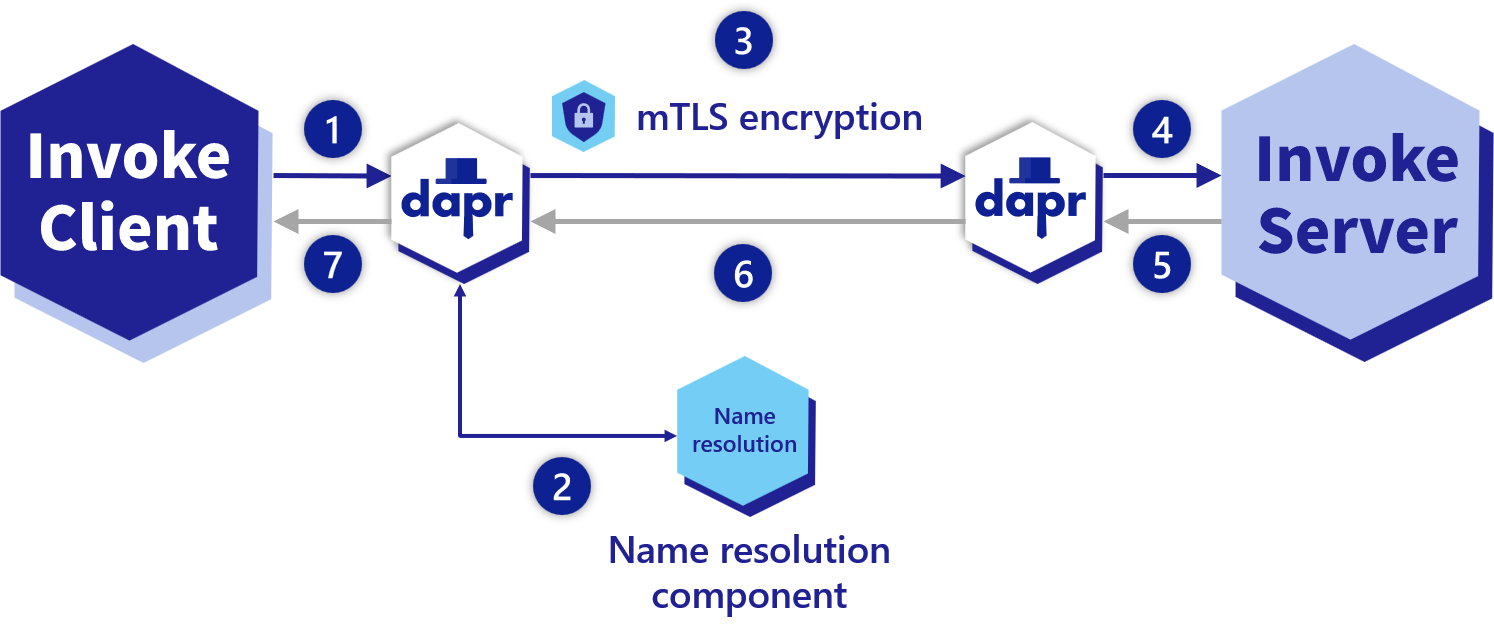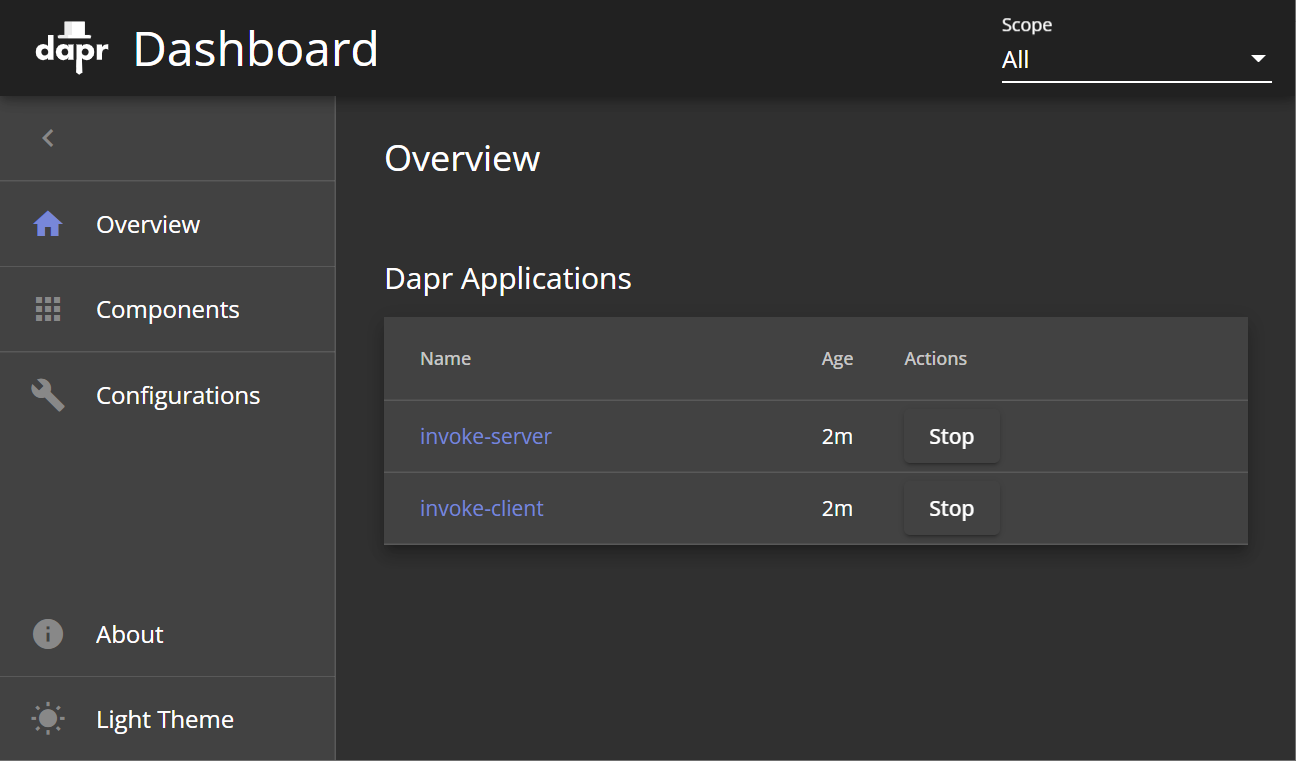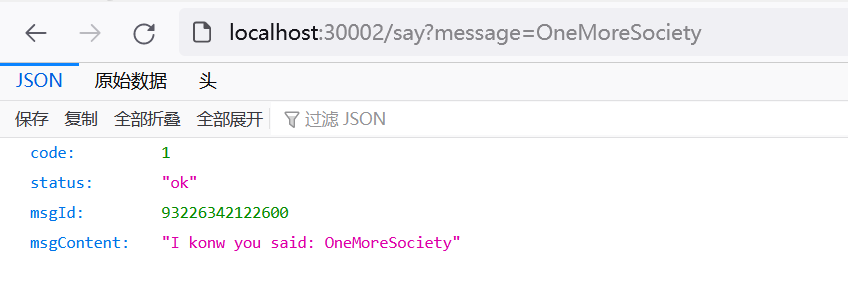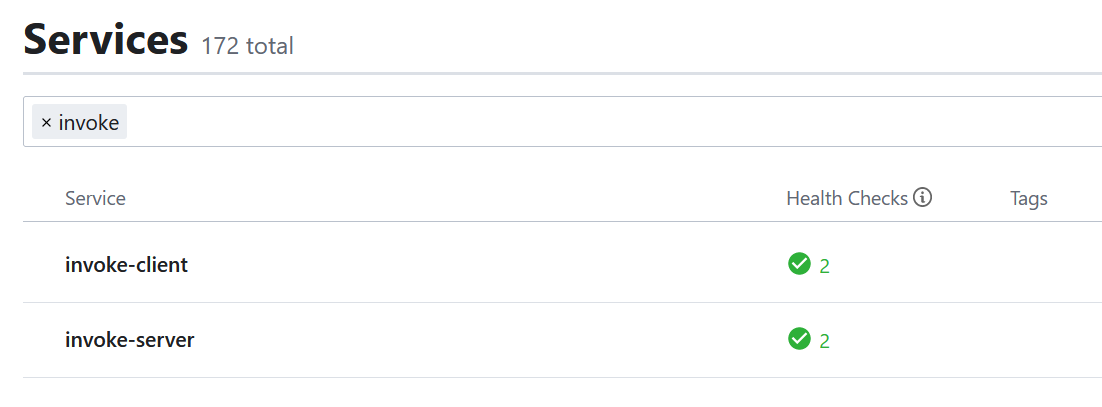服务调用
通过服务调用(Service-to-service Invocation),服务可以使用 gRPC 或 HTTP 这样的标准协议来发现并可靠地与其他服务通信。
Dapr 采用边车(Sidecar)、去中心化的架构。 要使用 Dapr 来调用服务,可以在任意 Dapr 实例上使用 invoke 这个 API。 边车编程模型鼓励每个服务与自己的 Dapr 实例对话。 Dapr 实例会相互发现并进行通信。
创建项目
创建两个 SpringBoot 项目,分别命名为:invoke-server和invoke-client。invoke-server作为下游服务,被invoke-client调用,具体调用过程如下图:
调用过程包括:
invoke-client服务对invoke-server服务发起 HTTP 或 gRPC 调用的时候,访问invoke-client服务的 Dapr 实例。
invoke-client服务的 Dapr 实例通过运行在给定托管平台上服务名解析组件(Name Resolution Component)发现了运行在此 Dapr 环境中的invoke-server服务。
invoke-client服务的 Dapr 实例将消息转发到服务invoke-server服务的 Dapr 实例。Dapr 实例之间的所有调用考虑到性能都优先使用 gRPC。 仅服务与 Dapr 实例之间的调用可以是 HTTP 或 gRPC。
invoke-server服务的 Dapr 实例将请求转发至invoke-server服务上的特定端点或方法,随后运行其业务逻辑代码。
invoke-server服务返回响应信息给invoke-client服务时,响应信息给将转至invoke-server服务的 Dapr 实例。
invoke-server服务的 Dapr 实例消息转发至invoke-client服务的 Dapr 实例。
invoke-client服务接收到其 Dapr 实例的响应信息。
编写 invoke-server 的代码
调用/send接口时,返回对应信息,主要代码如下:
package one.more.society.invoke.server;
import lombok.extern.slf4j.Slf4j;import org.springframework.web.bind.annotation.RequestBody;import org.springframework.web.bind.annotation.RequestMapping;import org.springframework.web.bind.annotation.RequestMethod;import org.springframework.web.bind.annotation.RestController;
@Slf4j@RestControllerpublic class InvokeServerController {
@RequestMapping(value = "/send", method = RequestMethod.POST) public InvokeResponse send(@RequestBody InvokeRequest request) { log.info("send - request:{}", request);
InvokeResponse response = new InvokeResponse(); response.setCode(1); response.setStatus("ok"); response.setMsgId(System.nanoTime()); response.setMsgContent("I konw you said: " + request.getMsgContent());
return response; }}
复制代码
其中,InvokeRequest和InvokeResponse的源码如下:
package one.more.society.invoke.server;
import lombok.Data;
@Datapublic class InvokeRequest {
private Long msgId; private String msgContent;}
复制代码
package one.more.society.invoke.server;
import lombok.Data;
@Datapublic class InvokeResponse {
private int code; private String status; private Long msgId; private String msgContent;}
复制代码
在application.properties中配置:
编写 invoke-client
在invoke-client项目的pom.xml文件中添加如下依赖:
<dependency> <groupId>io.dapr</groupId> <artifactId>dapr-sdk-springboot</artifactId> <version>1.4.0</version></dependency><dependency> <groupId>com.squareup.okhttp3</groupId> <artifactId>okhttp</artifactId> <version>4.9.3</version></dependency>
复制代码
注入一个DaprClient的 bean:
@Configurationpublic class DaprConfig {
private static final DaprClientBuilder BUILDER = new DaprClientBuilder();
@Bean public DaprClient buildDaprClient() { return BUILDER.build(); }}
复制代码
调用invoke-server的/send接口,主要代码如下:
package one.more.society.invoke.client;
import io.dapr.client.DaprClient;import io.dapr.client.domain.HttpExtension;import lombok.extern.slf4j.Slf4j;import org.springframework.beans.factory.annotation.Autowired;import org.springframework.web.bind.annotation.RequestMapping;import org.springframework.web.bind.annotation.RequestMethod;import org.springframework.web.bind.annotation.RestController;
@Slf4j@RestControllerpublic class InvokeClientController {
@Autowired private DaprClient client;
private static final String SERVICE_APP_ID = "invoke-server"; private static final String METHOD_NAME = "send";
@RequestMapping(value = "/say", method = RequestMethod.GET) public InvokeResponse say(String message) { log.info("send - message:{}", message);
InvokeRequest request = new InvokeRequest(); request.setMsgId(System.nanoTime()); request.setMsgContent(message);
InvokeResponse response = client.invokeMethod( SERVICE_APP_ID, METHOD_NAME, request, HttpExtension.POST, InvokeResponse.class).block();
return response; }}
复制代码
其中,InvokeRequest、InvokeResponse的源码与invoke-server中是一样的。
在application.properties中配置:
启动服务
在启动之前先用mvn命令打包:
在invoke-server项目的目录中执行以下命令,启动invoke-server服务:
dapr run --app-id invoke-server --app-port 30001 --dapr-http-port 31001 -- java -jar target/invoke-server-0.0.1-SNAPSHOT.jar
复制代码
在invoke-client项目的目录中执行以下命令,启动invoke-client服务:
dapr run --app-id invoke-client --app-port 30002 --dapr-http-port 31002 -- java -jar target/invoke-client-0.0.1-SNAPSHOT.jar
复制代码
在 Dapr Dashboard 中看到:
两个服务都已经启动成功。
访问http://localhost:30002/say?message=OneMoreSociety验证整个调用流程:
可以看到服务之间的调用没有问题,并返回了预想的结果。
名称解析组件
为了启用服务发现和服务调用,Dapr 使用可插拔的名称解析组件。 Kubernetes 名称解析组件使用 Kubernetes DNS 服务来解析集群中运行的其他服务的位置;自托管机器可以使用 mDNS 名称解析组件。
Consul 名称解析组件可以在任何托管环境中使用,包括 Kubernetes 或自托管环境。下面让我们来尝试一下,使用 Consul 作为名称解析组件。
在用户目录下的.dapr文件夹中,找到config.yaml文件。在该文件中,添加一个nameResolution的spec ,并将component字段设置为consul,比如:
apiVersion: dapr.io/v1alpha1kind: Configurationmetadata: name: daprConfigspec: nameResolution: component: "consul" configuration: client: address: "127.0.0.1:8500" selfRegister: true
复制代码
重新启动服务,可以在日志中看到注册到了 Consul 上:
time="14:28:54.4540593+08:00" level=info msg="service:invoke-client registered on consul agent" app_id=invoke-client instance=OneMoreSociety scope=dapr.contrib type=log ver=1.7.3time="14:28:54.4550937+08:00" level=info msg="Initialized name resolution to consul" app_id=invoke-client instance=OneMoreSociety scope=dapr.runtime type=log ver=1.7.3
复制代码
在 Consul 中也可以看到两个服务都已经注册上去了,如下图:
值得注意的是:Consul 名称解析组件目前还处于 Alpha 状态,最好不要在生产环境使用。
更详细的配置说明见下表:
配置示例:
apiVersion: dapr.io/v1alpha1kind: Configurationmetadata: name: appconfigspec: nameResolution: component: "consul" configuration: client: address: "127.0.0.1:8500" selfRegister: true checks: - name: "Dapr Health Status" checkID: "daprHealth:${APP_ID}" interval: "15s", http: "http://${HOST_ADDRESS}:${DAPR_HTTP_PORT}/v1.0/healthz" - name: "Service Health Status" checkID: "serviceHealth:${APP_ID}" interval: "15s", http: "http://${HOST_ADDRESS}:${APP_PORT}/health" tags: - "dapr" - "v1" - "${OTHER_ENV_VARIABLE}" meta: DAPR_METRICS_PORT: "${DAPR_METRICS_PORT}" DAPR_PROFILE_PORT: "${DAPR_PROFILE_PORT}" daprPortMetaKey: "DAPR_PORT" queryOptions: useCache: true filter: "Checks.ServiceTags contains dapr"
复制代码
最后,感谢你这么帅,还给我点赞。
















评论